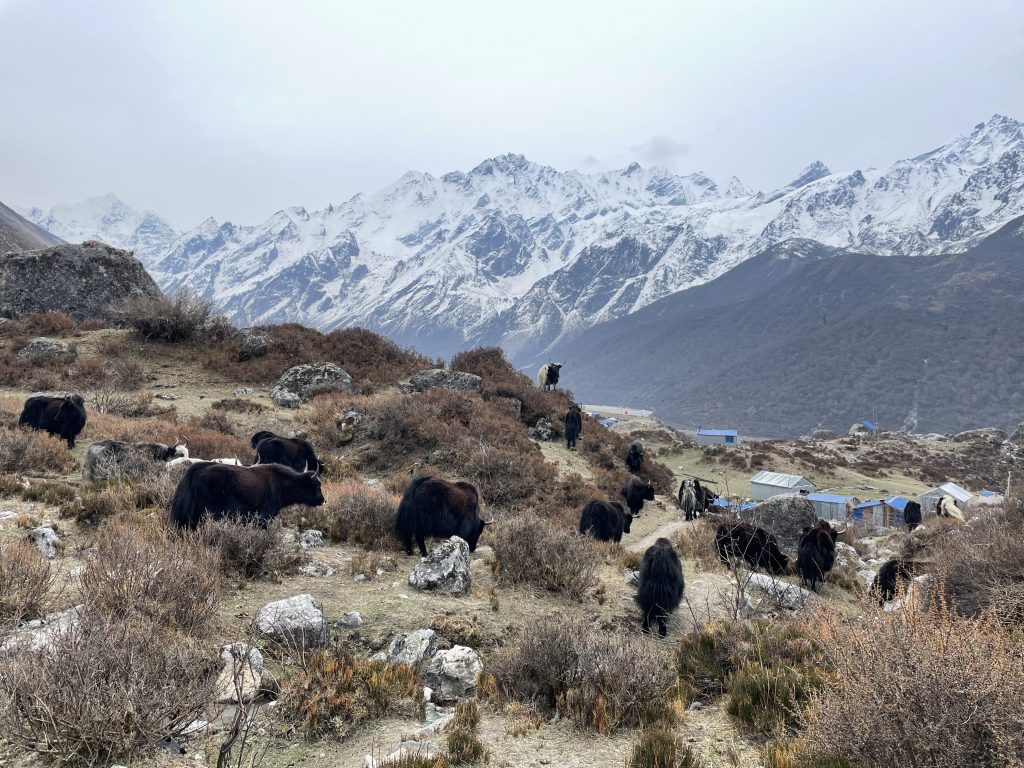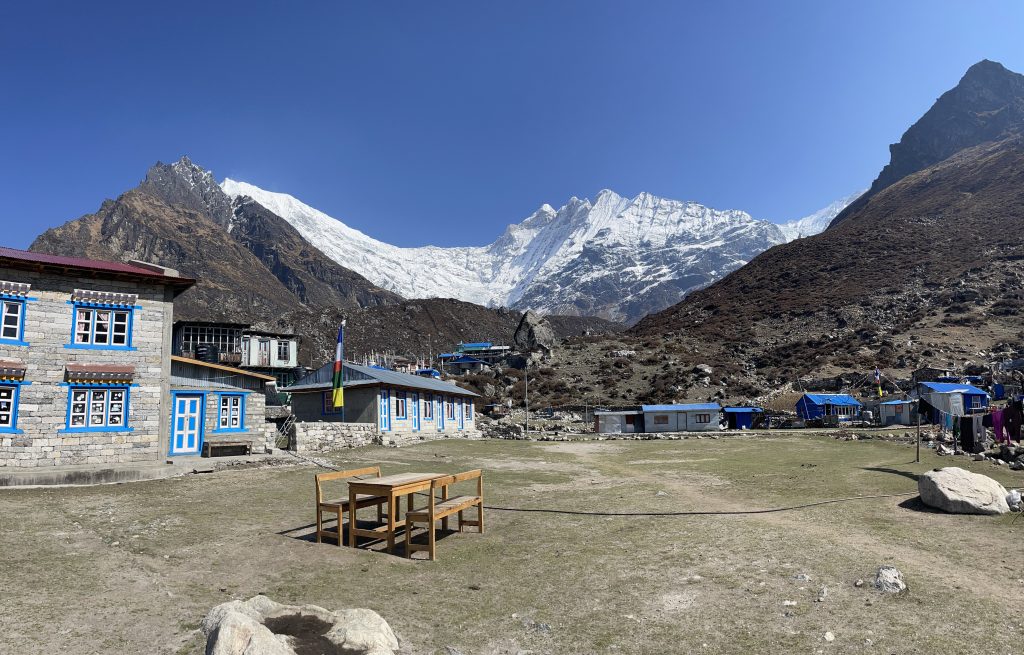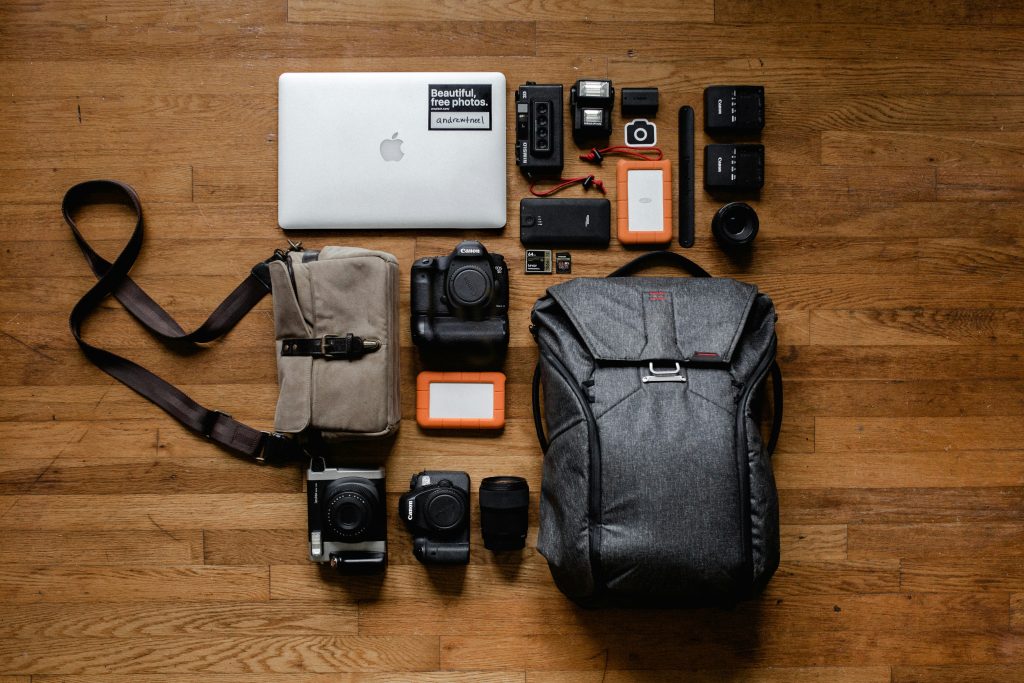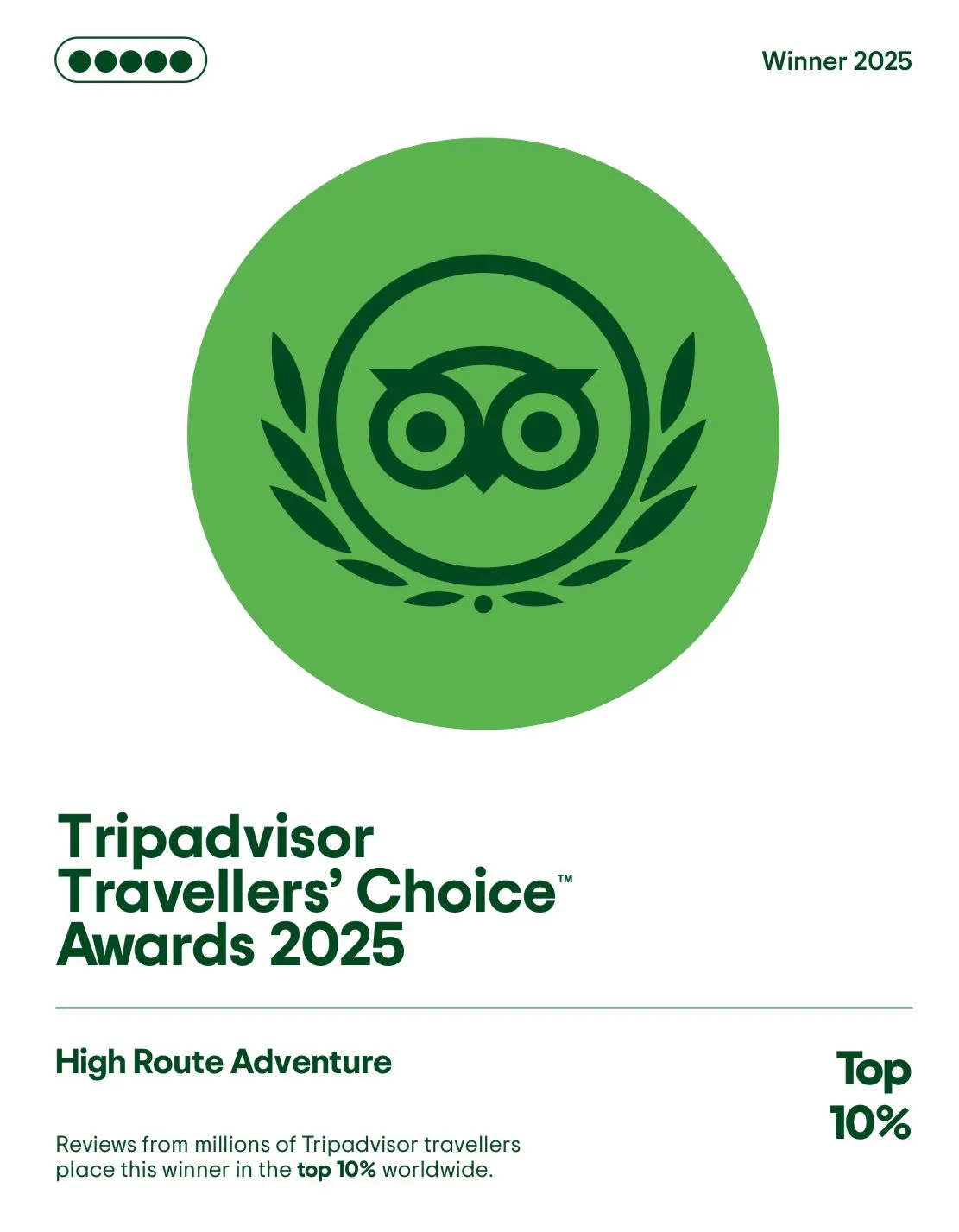A Complete Guide on Langtang Valley Trek

Langtang Valley trek is one of the most rewarding and worthy treks in the central part of the Himalayas. This trek takes you through Langtang National Park and Tamang community culture. Additionally, you will pass through the lush forest, the Langtang mountain range. Every novice trekker can achieve the Langtang Valley trek easily with proper guide and preparation.
Langtang Valley Trek is regarded as the third most visited trekking destination. The highest elevation you will reach is 4984m in the glacial terrain.
Check out: Short Langtang Valley Trek Package From Kathmandu
Table of Contents
Trip Facts
| Trip Days | 11 Days |
| Trekking Days | 7 Days |
| Highest Point | 4984m/16351ft at Tserko Ri peak |
| Difficulty | Moderate to Difficult |
| Permits | TIMS And Langtang National Park entry fee |
| Accommodation | Hotel/Teahouse |
| Best Season | spring season(March-May) And Autumn Season(Mid September-November) |
| Average Walking | 5 to 6 Hours |
Key highlights of Langtang Valley Trek
- No need for a flight, you can reach the Langtang region in a drive of 7 to 8 hours
- Experience the ethnic Tamang communities’ culture along with multicultural cuisine and amazing warm spirit scenery
- Explore the several kinds of flora and fauna at a Himalayan national park (Nepal’s first Himalayan park) and Langtang National park (Fourth protected area)
- You can be lucky to spot rare Red Panda and pass through rhododendron trees during your forestry trail
- You can picturesque the mesmerizing view of mountain peaks like Langtang Lirung, Yala Peak, Loenpo Gang, Langtang Ri, Dorje Lakpa, and much more
- You can visit the area which is badly hit by the 2015 earthquake
- Encounter with the oldest Buddhist monastery in Kyangiin Gompa and visit the famous cheese factory over there
- you will reach the highest elevation of the trek- Kyangiin Ri (4,984m/16,351ft) to get precise views of the great Langtang Range
For more details: Top 10 Things to Do in Langtang Valley TrekLangtang Valley Trek Itinerary
| Day | Itinerary | Altitude | Meals | Accommodation |
| 01 | Arrival in Kathmandu | 1350m | Breakfast | Hotel |
| 02 | Kathmandu Sightseeing and Trek Preparation | 1350m | Breakfast | Hotel |
| 03 | Drive from Kathmandu to Syabrubensi | 1500m | Breakfast/Lunch/Dinner | Teahouse |
| 04 | Trek from Syabrubensi to Lama Hotel | 2380m | Breakfast/Lunch/Dinner | Teahouse |
| 05 | Trek from Lama Hotel to Mundu via Langtang village | 3543m | Breakfast/Lunch/Dinner | Teahouse |
| 06 | Trek from Mundu to Kyanjin Gompa | 3830m | Breakfast/Lunch/Dinner | Teahouse |
| 07 | Acclimatization- Explore Tserko RI (5000 m) | 3830m | Breakfast/Lunch/Dinner | Teahouse |
| 08 | Trek from Kyanjin Gompa to Lama Hotel | 2380m | Breakfast/Lunch/Dinner | Teahouse |
| 09 | Lama Hotel to Syabrubesi: | 1500m | Breakfast/Lunch/Dinner | Teahouse |
| 10 | Drive from Syabrubensi to Kathmandu | 1350 | Breakfast/Lunch/Dinner | Hotel |
| 11 | Final departure | Breakfast |
Plan your adventure with us?
Talk to our expert team to plan your trip in Nepal.
Recommend reading: Langtang Valley Trek Package 10 DaysRequired Permits For Langtang Valley Trek
The Langtang Valley trekking route falls in a protected area – Langtang National Park, which requires an entry permit that allows the trail. Besides this, trekkers must get a trekkers information Management System (TIMS) card before making the trekking move in the Langtang Valley and most of the trekking region in Nepal.
A detail of permit cost per person at the Langtang Valley is given below:
- For foreigners: NPR 3000 (Approx. USD 30) plus 13% VAT
- For SAARC nationals: NPR 1500 (Approx. USD 15) plus 13% VAT
- TIMS permit for both: NPR 1000 (Approx. USD 10)
You can obtain your entry permits from the Nepal Tourism Board office at Pradashani Marg, Kathmandu. You can collect at office hours from Sunday to Saturday from 9:00 am to 4:00 pm. An alternative option is also available to obtain permits from the second checkpoint on your way to Syabrubeshi.
you have to carry all the necessary documents such as your passport copy, insurance policy number, detailed itinerary information, and some passport-sized photos. It will be easier for you if you take a package trip from a local agency as they will manage everything needed for the permits.
Note: you have to show your entry permits at all the respective checkpoints. It is better to keep documents safe. All the permits are non-refundable and non-transferable. Besides this, no entry fee is needed for children below 10 years.
You may also like: How to Obtain Permits for the Langtang Valley Trek?Where is Langtang Valley Trek Located?
Langtang Valley is located just 51 km far from the north of Kathmandu in the north-central Rasuwa District. Langtang Valley extends from east to west including Langtang National Park and is surrounded by Tibet on the north side.
Mesmerizing Langtang Lirung mountain amidst several ranges welcomes you. you will pass through the lush Langtang River and Bhote Khosi River at the western end of the Langtang valley. Moreover, your trekking trail will be through an ancient trade route following the tributary above Dhunche while you can picturesque the view of the great Himalayas such as Ganesh and Langtang peaks extending towards the Kerung border to Tibet.
Langtang Valley is basically famous for its natural beauty and moderate climate. Several local villages, tea houses, lama hotels, and Kyangjin Gompa are some tourist choices in this Himalayan region.
How to Get in Langtang Valley?
Langtang valley is 51 km far away from Kathmandu city. Your trekking starting point begins from Syabrubesi, which is 115 km away from Kathmandu. After 7 to 8 hours of drive from Kathmandu, you will reach Syabrubesi – the main trek point. You will travel on the comfortable jeep or any private vehicle provided by the agency. You will pass through several parts of the road such as black pitched, gravel, and muddy in some parts.
You can choose your way of travel in terms of your budget. However, if you choose a local bus then you have to reach the Gongabu Bus Station early morning at 6 Am or 7 Am. You will find this local bus a little bit crowded and typically slowly in comparison to other means. Besides this, you have two more option to travel one is by a sharing vehicle and next one is the tourist bus which costs, USD 10 and USD 8 to 9 respectively.
Additionally, you have the next option to travel from a private vehicle to get a more comfortable and luxurious experience throughout your journey. Generally, this private rental charges a high cost in comparison to other options.
Note: You can reach Syabrubesi – the starting point for the Langtang Valley trek by three different ways via local bus, private rental vehicles, and jeeps according to your budget and comfort.
Langtang Valley Trek – Difficulty and Preparation
Langtang trek will take you to an elevation of 4,500m/14,763ft. However, you will spend a night at the altitude of 3830m/12566 ft situated at the Kyangjin Gompa. some of you may feel altitude sickness at this level. Trekking is considered to be moderately difficult as it can be a cover-up by every type of trekker.
The Langtang Valley trek lasts for 7 days. You will have to trek normally 6 to 7 hours per day to reach your destination point. Furthermore, you need to trek more than normal hours or can be less, someday by considering certain facts which may come your way. The trekking trail passes through several landscapes, scenery, and rugged terrain.
This trek is quite famous for regular trekkers and a good starting trek journey for amateurs who are physically and mentally fit. To avoid trekking difficulties, you need to boost your energy level. Additionally, you can practice swimming, cycling, hiking, yoga, and exercise a couple of weeks before the trek at the Langtang region. As your trek goes through the high altitude, you need to quit your smoking and drinking habit. Such a habit may cause you to lose your stamina and immunity, due to which you will be unable to reach your destination.
More Detail: How Difficult Is the Langtang Valley TrekAltitude Sickness- How to Avoid Altitude Sickness on Langtang Valley Trek?
Altitude sickness is common to happen when you trek in the Himalayan region above 2500 meters. Moreover, trekkers may suffer from altitude sickness at the Langtang Valley trek in comparison to the Annapurna base camp trek because of the maximum elevation of 4,984m/16.351 ft at Tserko Ri.
You will feel the slight and sudden change in your move for the first few days because of the elevation. The more you step forward; your body finds it difficult to be compatible with the surroundings at the oxygen level atmospheric pressure drops down and the air becomes thin.
Acute Mountain Sickness (AMS) and Altitude sickness are the two most common forms of altitude sickness you may suffer above 3000m/ 9842ft. Mild symptoms like headache, fatigue discomfort, and insomnia might be experienced.
Additionally, you might experience severe symptoms such as dizziness, rapid heartbeat, loss of appetite, and vomiting. To avoid such symptoms, you need to follow precautions, be aware, and be safe. Besides this, a good diet, a detailed itinerary including acclimatization day, and a good warm-up exercise are needed to reduce AMS.
Note: Diamox Tablets can be taken, once you get a prescription from the doctor to eliminate risk. If you feel uneasiness and get a symptom as mentioned you need to quickly inform your tour guide, porter, to assist you. Prevention is better than cure.
Best Season For Langtang Valley Trek

Langtang Valley is situated in the central Himalayan region, which is why the best season to visit Langtang is considered to be during the month of spring season (March to May) and Autumn (mid-September to November). These seasons are best to travel and gather memories in most parts of Nepal.
During the spring season, you will feel the chill and cold weather and the views are amazing. You will find the different flora and fauna, wildflowers, and rhododendrons blooming along the trail. The temperature in the spring season ranges from 10 to 22 degrees Celsius (50 to 71 degrees Fahrenheit) in the daytime. The mesmerizing view of Tserko Ri is seen vividly and it is worth capturing.
Furthermore, the Autumn season is regarded as the best season to trek in the Langtang region. The days are shorter, warm, and sunny. You can get a chance to celebrate Nepal’s two most important festivals, Dashain and Tihar during this season. Experiencing and exploring the culture and tradition of Nepal will get you to another point in your trek journey.
Additionally, some trekkers choose to trek during the month of the Winter season (December to February). The days are cold and night is chilly and long at this time. Even the temperature may drop down to -3 degrees Celsius in January. Extra precautions and heavy clothing are needed to prevent you, from suffering from AMS and frostbite. Besides this, summer and Monsoon season are also included in the list but it is strongly not recommended as the views might be blurry and weather conditions may change frequently.
More Details: When is the Best Time for the Langtang Valley Trek?Food On Langtang Valley Trek: What to Expeact

Food is an essential part of our life. Whenever it comes to trek, a portion of healthy and nutritious food is needed to boost one’s immunity power. During your trekking trail, food is available as per your taste but we prefer you to have Nepalese cuisine. The meals here are very delicious and warm. Dal Bhat tarkari – (Lentils, rice, vegetables) is a predominantly local dish you must try. Other local delicacies such as yak cheese, Tibetan butter tea, and Tibetan bread with boiled and fried potatoes are famous cuisines you will get to taste once you reach the Langtang region.
Additionally, your tea houses and lodges offer you a menu of American, Italian, French, and Korean dishes. You can choose according to your taste and preference. You will find the dishes a little bit more costly than at Kathmandu.
We suggest you carry water-purifying tablets and some dry fruits, cookies, chewing gum, Choco chips, energy bars, granola bars, and dry fruits on your own. You can buy these items at one of the supermarkets in Kathmandu because the price is double at higher altitudes due to transportation charges.
Accommodation at Langtang Valley Trek

Accommodation is arranged at local tea houses with basic facilities. Star hotels are arranged during your stay in Kathmandu. The bed will be comfortable, and neat, and a clean bathroom is available. As your trek begins from Syabrubesi, then your accommodation will be arranged at local tea houses. You will find newly built tea houses.
The room is separated by thin walls and you will be sharing the room with the same gender. You have an option to sleep at the teahouse bed or you can sleep in your sleeping bag if you carry one. The rooms are clean and multiple beds are arranged in shared rooms. However, you can stay in a single room by paying extra charges.
You will find tea houses full of trekkers during the peak season of the trek. Furthermore, agencies will help you to settle down at one of the local tea houses. You need to share common bathrooms. The toilet seats will be squat. You have to be sure to carry toiletries in your bag pack.
Read more: Food and Accomondation in Langtang Valley TrekInternet Connectivity and Electricity at Langtang Valley Trek
Internet and electricity facilities are available during your trek trail. However, you might face an electricity power cut-off sometimes. Some of the tea houses may charge you extra internet charges and electricity charges as you charge your phone and batteries. Wi-Fi is available at the teahouse you stay in.
You need to get a sim card of NTC and NCELL in Kathmandu to get connected with friends, family, and agencies. Additionally, you can buy mobile data once you install your SIM card on your mobile phone. You need to carry an extra power bank or solar charger if possible. The electricity power and lights tend to be of low voltage as you ascend higher.
Langtang Valley Trek Cost
Langtang trek cost is relatively dependent on the type of trek days, season, and agencies. Additionally, cost also depends on transportation, food, accommodation, hiring travel agencies, hiring guides porter charges, group, and individual.
Comparatively, the cost of the Langtang trek is relatively less than the trek in the Everest region and Annapurna region as it is very close to Kathmandu city.
Read more: Langtang Valley Trek CostLangtang Valley Trek All–Inclusive Package
Langtang trek package price ranges from USD 900 to USD 1500 if you choose the agency’s offer package. The package includes all the basic services needed such as food, accommodation, domestic transport, entry and permits, porter and guide, tea and coffee breaks, and so on at your trial. Cost varies according to agencies. It will be beneficial for you to choose and book a local travel agency than a foreign travel agency. Local travel agencies have more networks, connections, and experience in managing treks peacefully.
Furthermore, the Langtang trek package doesn’t include any personal expenses, hot showers, extra assistance, recharges, souvenirs, bar bills, internet connectivity charges, and many more. All the personal expenses should be borne by you in your way including your International flights as well. You have to carry a certain amount of money separately for your miscellaneous expenses.
Langtang Valle Trek Independently
Langtang valley trek can be managed in your own way without any help from travel agencies. For this, you can hire a porter and guide personally. Alternatively, you can do a solo trek with your group as well. Independent trek is suggested only if you are an experienced trekker and familiar with Nepalese trekking routes, culture, and language in a very good way. All kinds of documentation, food, accommodation, entry, and permits have to be managed by yourself. This might bring you the hassle and run around you here and there.
Independent trekking’s estimated cost can range from USD 700 to USD 1000, depending on the travel season, the option to hire a porter and personal guide, accommodation, and food, you choose.
Updated: Now Solo Trekking is banned. Trekker must hire the trekking Guide with them.
Hiring a Guide and Porter for Langtang Valley Trek

You can set up the contact to local guides who will assist you in setting up your trip only. However, you also have an opt-out option to hire guides and porters with/without the help of travel agencies.
You need to cover and manage porters/guides’ food, accommodation, travel expenses, tips, and insurance while traveling.
The general cost of hiring a porter and guide for the Langtang trek is given below:
- Guide: You have to pay USD 30 to USD 35/day( plus a tip)
- Porter: You have to pay USD 20 to USD 25/day( plus tips)
- Porter Cum Guide: You have to pay USD 25 to 30 USD 25/day( plus tips)
It will be easier for you to trek in the Langtang region with a guide as they know all the local languages and have trekking experience over there. Additionally, the porter will carry your luggage, and bag pack to make your trek easier.
What to Pack for Langtang Valley Trek?

Gears and equipment depend upon the season you choose to trek and travel. During your trek trail to Langtang, you will be taken to an elevation above 4500 m / 14763 ft. The weather becomes cold once you cross the elevation of 2500m. You have to keep the weather in consideration while traveling. The temperature goes down to zero degrees in the winter season, while a cold breeze of air passes in the spring and at the end of Autumn.
There is the most important equipment you need to carry by yourself while trekking in the Langtang region. They are listed below:
- First aid kit
- Pairs of sturdy shoes and trekking poles
- Down jacket, warm clothes
- Hiking shoes and socks
- Toiletries and personal hygiene things such as brushes, feminine products, paste, sanitizers, wet tissues, lotions, moisturizers, etc.
- Cotton t-shirt, pants, and sweatshirt
- Headlamp
- Gadgets
- Battery charger
- Daypack and bag pack
- Glucose and other energy drinks
- Chewing gum, chocolates, bars
- Water purifying tablets
- Sunglasses, hats, EarPods
- Sleeping liners and sleeping bags
- Money pouch, water bottles
- Daily itinerary notes
The above-mentioned are the essentials that you must carry while trekking in the Langtang region. However, you can avoid sleep liners, sleeping bags, and camping gear like gaiters and crampons as it is a moderate trek.
Note: You can leave your other unnecessary items and luggage in your hotel room where you stayed back in Kathmandu. The hotel staff will keep your baggage with due care and safety.
Guided Tour vs Independent Trek: Langtang Valley Trek
A guided tour is easier for the trekkers for the Langtang Valley trek. You have two options to trek in the Langtang region. It is either by guided trek or by independent trek. Most of the trekker’s choices are guided treks it across rural areas and in high altitudes, which should be done under the supervision of some experienced traveler.
There will be no worry about documentation, permit, entry, food, and accommodation on your route if you choose to do a guided tour. You can hire a guide through your travel agency or by personal contact.
Furthermore, you can go for an independent trek, if you want to go for a solo trek. If you choose so, then you have to bear all kinds of responsibilities such as documentation, entry, permits, food, accommodation, and many other things. You have to be health-conscious on your own. Though it is a cost-saving alternative, you have to face a lot of obstacles if you are unaware of the Nepalese language, culture, routes, and many more.
Importance of Travel Insurance for Langtang Valley Trek
Travel insurance is a must if you are going to trek in a high-risk area and if you choose to trek/travel outside your home country. Moreover, the trek is done at a high elevation of 4500m/14763 ft, which may cause Acute Mountain Sickness (AMS). Langtang lies in the high Himalayan region and with a limited facility for basic needs. So, if you fall sick/ injured seriously, you might be rescued through the helicopter which tends to be a high cost.
Travel insurance is done to get compensation if any kind of obstacle happens in your way during the trek. Before having any insurance, you need to be very careful and should read all the terms and conditions of the related insurance company. You must let your insurance company about your day-to-day itinerary, region of travel, and so on. Once your trekking finishes, you can cancel the insurance policy.
Langtang Valley Trek: After Earthquake
Langtang Valley is one of the prone areas which was badly affected by the 2015 earthquake in Nepal. Many locals and foreigners lost their lives during that time. Later on, the Langtang region villages were completely scattered and ruined due to a sudden landside which fell off at the south face of the Langtang Lirung. The medical supply and rescue team didn’t reach there for so many days due to blockage.
You will be across through many gompas, mani walls, few surviving houses on your route. After the huge devastating incident, now the Langtang village is drastically changing. Houses are rebuilt. Basic facilities have been upgraded.
You can find so many memories connected to ancient history and often can get information through locals about how the Langtang was before the earthquake. You can find bakeries, newly built tea houses, coffee shops, and properly managed trekking trails. The mesmerizing view of Langtang revives you internally, once you reach your destination.
Conclusion
Langtang valley trek is a memorable and rewarding trek that is just a few kilometers away from Kathmandu. You can see the people full of confidence and happy faces even after they suffer from the huge loss from the earthquake. You will find inspiration in every local of the Langtang region. You can stay at the newly built tea house and enjoy the panoramic views from there. Additionally, you can extend your trek. Many trekkers choose to trek to Gosaikunda Helambu and Tamang Heritage Trek once they get inside Langtang Valley.
High Route adventure gives you maximum satisfaction and provides you with a detailed itinerary for your easiness. We are always ready to make your trip memorable and fruitful.
Want to know more about Langtng Valley Trek?
Talk to our expert guides who is more aware about the climate and weather of Langtang Valley Trek.









